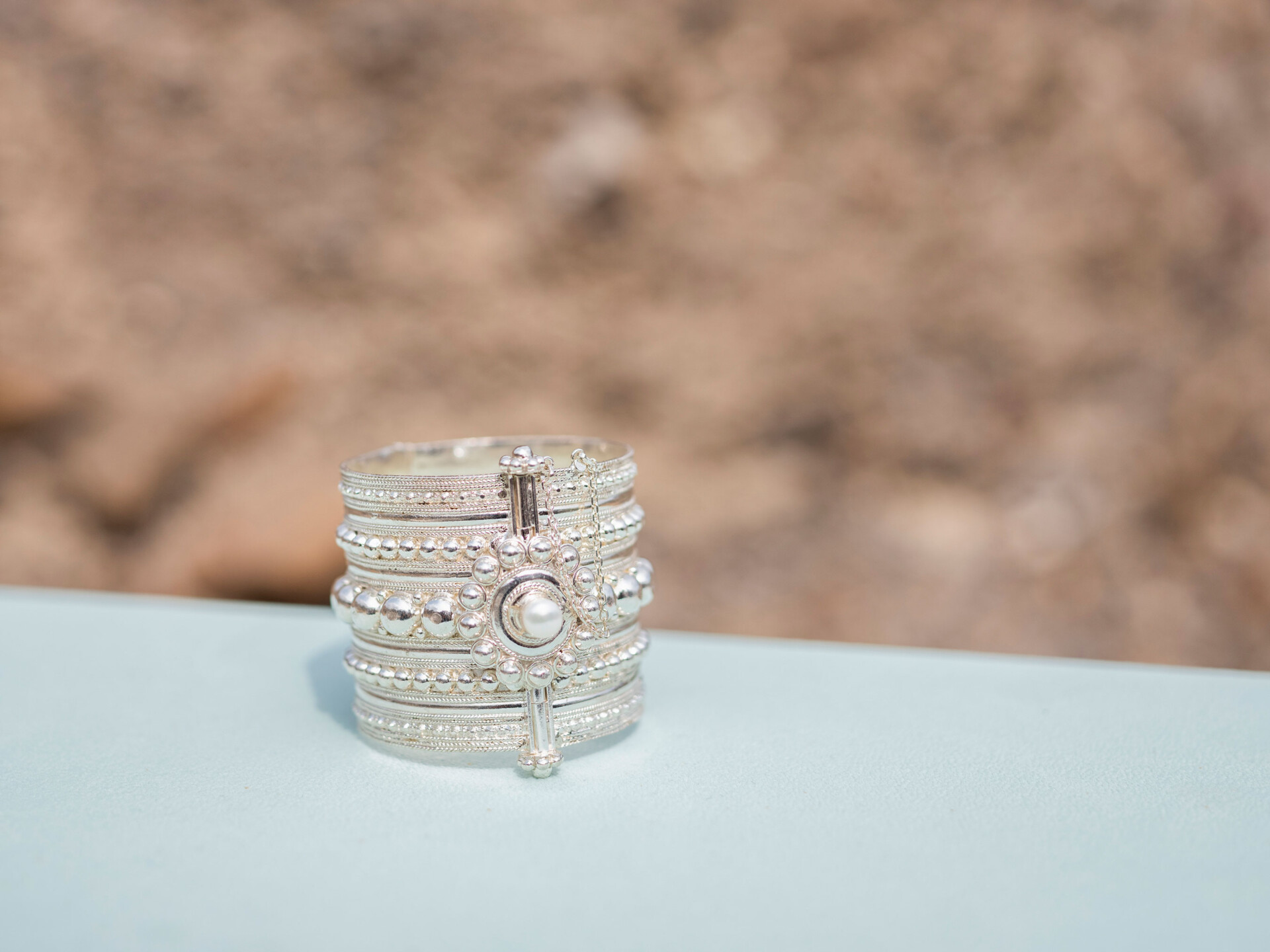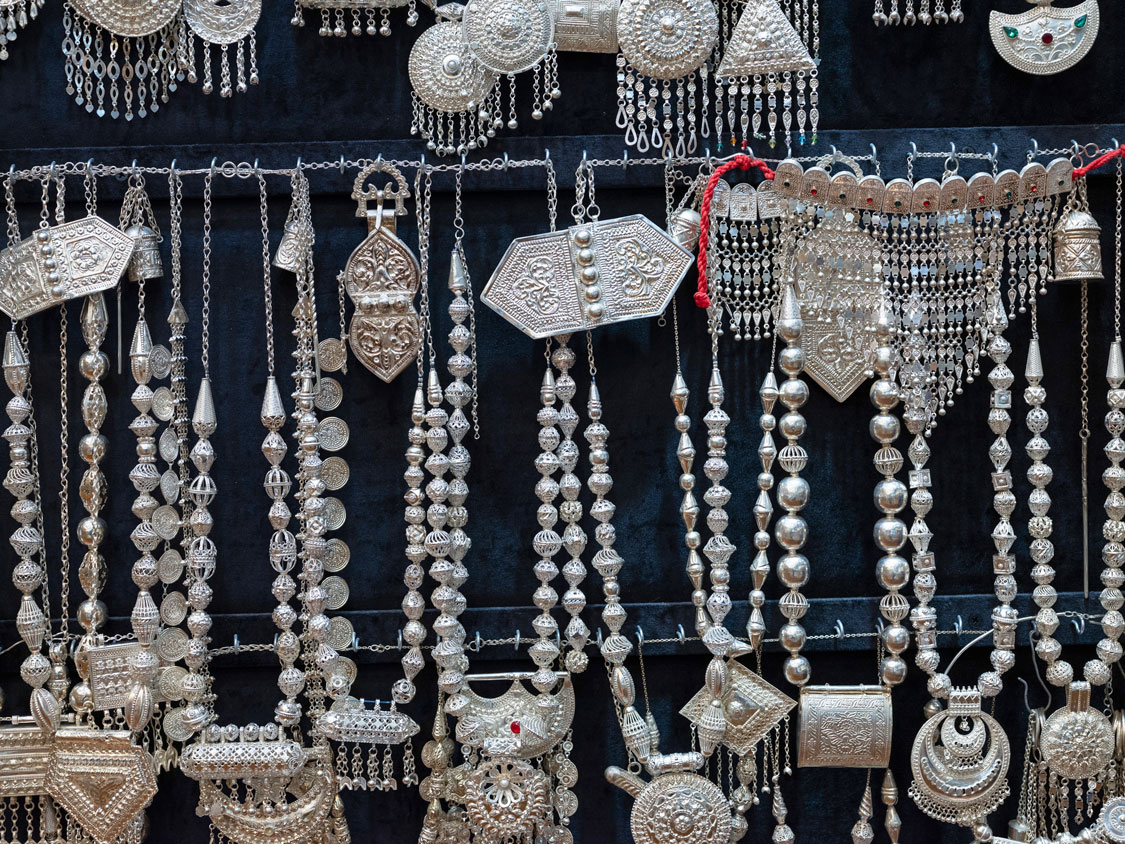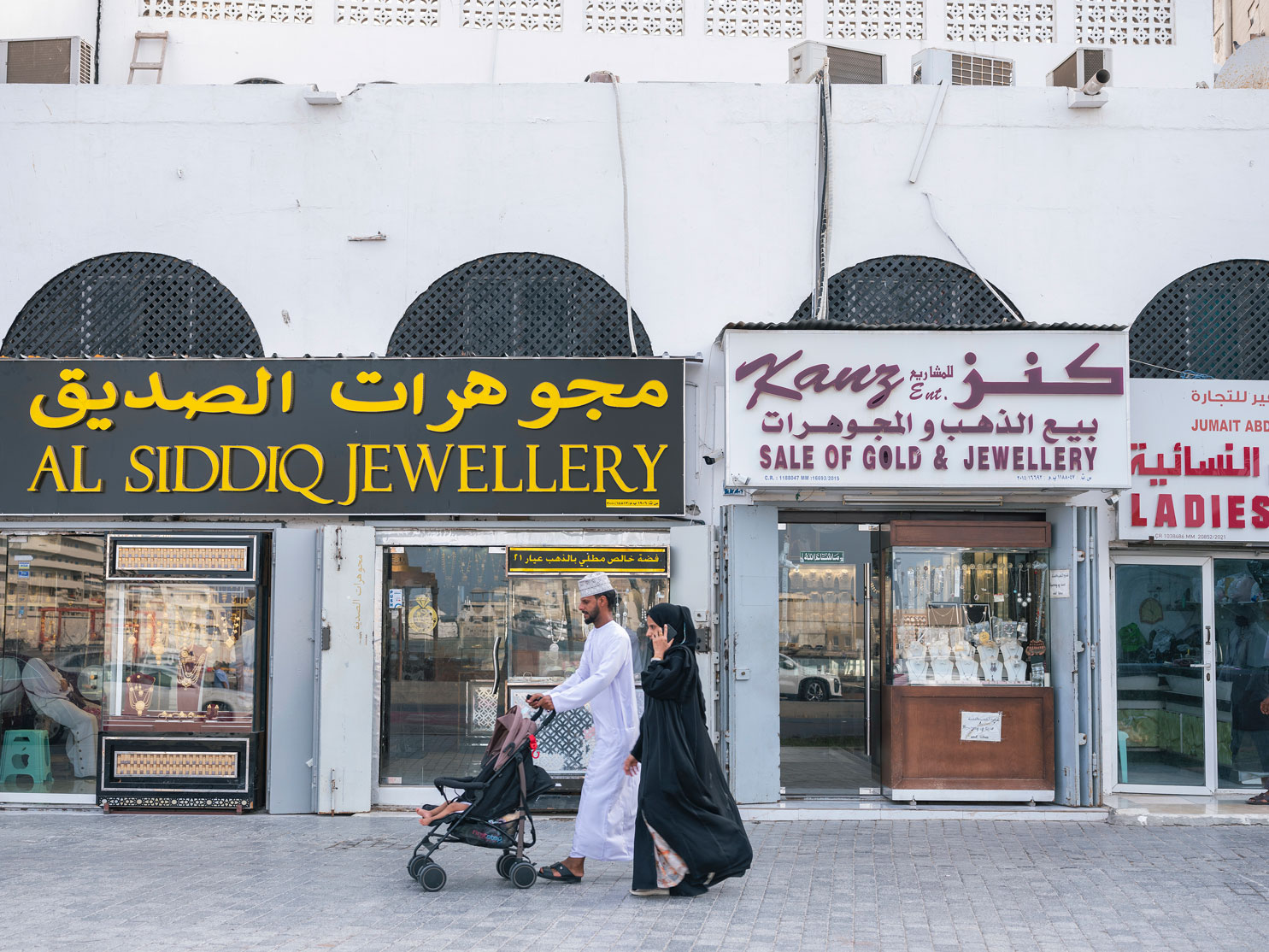When Amal Al Ismaili was 10, she opened the door to a traveling salesman who asked for her grandmother. He was not looking to sell anything, but to buy antique silver jewelry to resell or melt into new pieces.
“My mother always talks about the jewelry my grandmother had, how heavy it was and how she sold it all,” says Al Ismaili, remembering her grandmother handing over her engraved kohl holder and other pieces of ornate, antique jewelry to the trader.
“I felt that our heritage vanished, it was gone. So, I tried to trace it.”
Eventually, Al Ismaili found her way from the oasis town of Ibra to the United Kingdom, where she began to study the history of Omani silver and leather jewelry as part of her doctoral studies. She refined her skills, and started putting her knowledge of smithing together with the history of the craft and the politics that could affect its future. Her search for her Bedouin grandmother’s jewelry led to meetings with women across Oman’s desert interior, and when Al Ismaili finished her doctorate, she returned to Oman permanently to teach contemporary jewelry and handicrafts at Sultan Qaboos University in the capital of Muscat.
Al Ismaili is part of a new generation of Omani women who have taken up silversmithing, buoyed by modern technology, government classes in smithing and social media that enables them to reach wealthy consumers across the Arabian Peninsula. Silversmithing has traditionally been the purview of men smithing and selling their wares in the souks, yet as men pursue salaried government jobs, women are stepping in to keep silversmithing traditions alive. And as more and more of the traditional shops are shuttering their doors, women are creating workshops in their homes and building client bases on WhatsApp and Instagram.
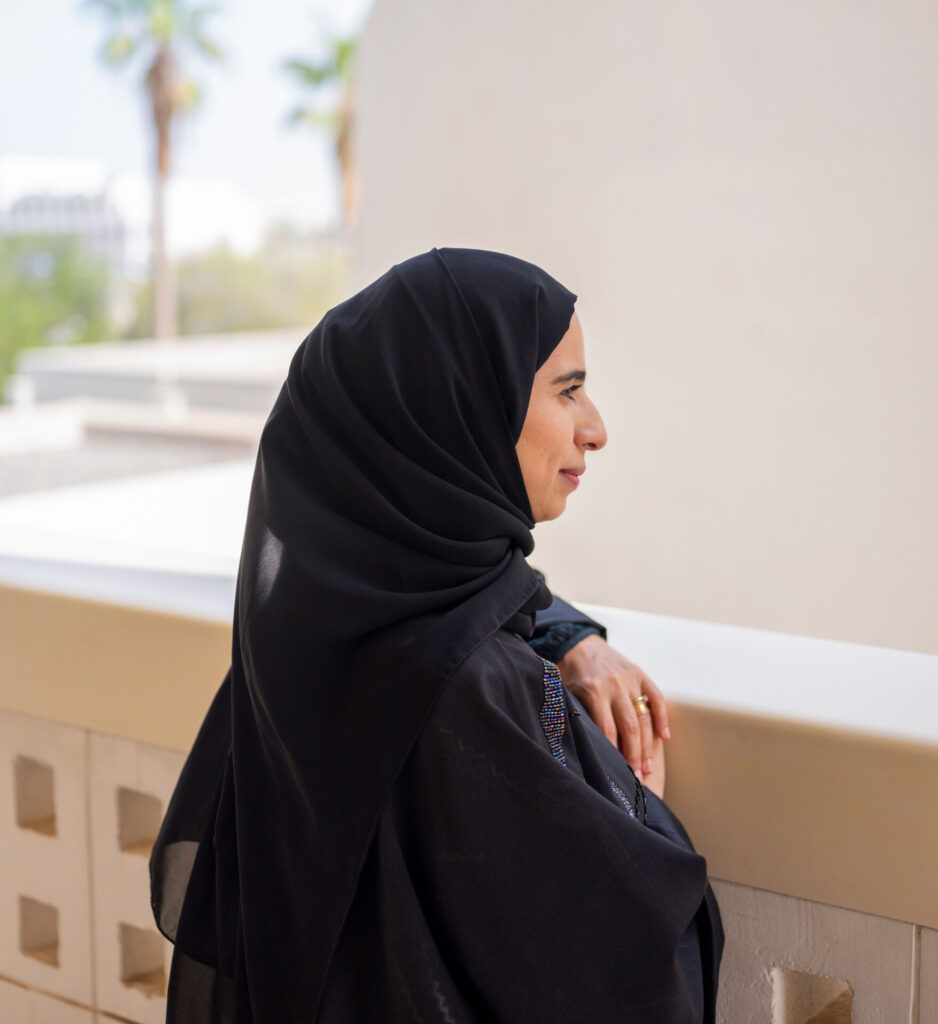
In Arabia, Oman has long been synonymous with silver. The metal was once worn at every milestone of life: both boys and girls had their ears pierced weeks after birth, and children wore heavy amulets for protection from the evil eye. The dowry given to a bride by her husband was her financial security, and generations of men worked at the forge, crafting everything from delicate toe rings and dainty kohl holders that held natural mascara to hefty swords and daggers like those found on the Omani flag.
“When you think of Oman, there are a couple of reasons why you think of silver,” says Marcia Dorr, a researcher behind an upcoming British Museum exhibition on women smiths from Oman who has worked with Omani craftswomen since the 1980s. “There was this rich confluence of inspiration, of ideas, of technologies from a very early time. Omanis were metallurgists from the beginning of civilization in the region and metallurgy skills translate to silver. The technologies and patterns have been used for thousands of years.”
Oman was perfectly placed to become a silversmithing center. At its height in the 19th century, its maritime empire extended from Bahrain in the north to modern-day Pakistan, and south to Zanzibar along swathes of Africa’s east coast.
This meant steady access to high-quality silver in the form of the Maria Theresa thaler, a bullion coin that bore the face of the powerful 18th-century ruler of the Habsburg Empire and Holy Roman Empress. Her eponymous silver coin was so prized for its purity that it was minted from Birmingham to Bombay and remained a currency in the Arabian Peninsula into the late 20th century. For centuries, Oman’s Indian Ocean mariners provided smiths with a steady supply of pure silver coins that were melted into new pieces or valued as medallions in their own right.
At the same time, Oman’s mobile Bedouin communities created demand. For them, jewelry was a portable bank account. While settled townsfolk had a permanent home, Bedouin women had to wear their silver, or pack it in small baskets as they moved from place to place. Most simply wore their wealth. Jewelry had to be strong and it had to be portable.
Oman had a large Bedouin population and many lush oasis towns bordering desert territories. This meant that stationary workshops flourished. Smiths were adept at designing for both desert nomads and the settled population of the mountains and coast. Styles within settled communities were as diverse as their inhabitants. Omani smiths might cater to Baluchi, Irani and Zanzibari communities, herdsmen from the tropical south and farmers from the limestone massifs of the Hajar mountains.

While styles were influenced by the convergence of Indian Ocean cultures, techniques long preceded the rise of Oman’s maritime empire. Take the light, airy filigree of silver in the coastal Dhofar region of Oman’s far south. Dhofar still holds close cultural ties to the Swahili coast of East Africa from centuries of trade and, unsurprisingly, Dhofari jewelry is like Zanzibari jewelry in its delicacy. But the fine work is also reminiscent of techniques used in goldsmithing and may be a clue to an even older culture, says Dorr.
Centuries before Oman grew its empire in the 18th century, the monsoon-swept south was renowned for frankincense, which was traded from India to Petra and Rome and brought the region incredible wealth. It is possible that the intricate bell earrings and fine chains of Dhofari jewelry originate from a time when gold was abundant on the southern coast, its popularity only later to be overtaken by silver.
“Frankincense was traded literally for gold, weighed against gold to determine its value,” says Dorr, who has co-authored a book on “The Craft Heritage Of Oman.” “If gold was much more available at another time in Dhofari history, that may have influenced the Dhofari designs we see made in silver today.”
In the north, buyers preferred thicker, clunkier jewelry. There, smiths had handed on metallurgical skills since the third millennium BCE, when copper was mined from the Hajar mountains and smelted, providing an important source of metal for Mesopotamia.
Each piece represents significant parts of a person’s identity, including their marital status, social status and faith. “It’s such an inextricable part of who people are, not just for centuries but for millennia,” notes Dorr.
For instance, many silver pieces were strictly for married women, like toe rings or the jingling anklets of bells worn for dancing in southern coastal communities. And for many, silver carried great spiritual significance. The popular teardrop-shaped shahid ring is worn on the index finger and associated with the Islamic Shahada, the declaration that there is no God but God and Muhammad is His Messenger. The hirz necklace, found throughout Oman, features an amulet box believed to protect its wearer from evil, and could contain verses of the Quran hidden inside. Medallions might also feature a stick figure representing a jinn with shackled ankles. This was to be put under a boy’s pillow or worn as a necklace to keep him safe from malevolent spirits.
“What I found is a remarkable continuity over time in Omani designs and that may be another reason why they’re so famous,” says Dorr. “They have, for centuries, been a part of Oman’s identity.”
This October, the British Museum will host an exhibition on female silversmiths of the 20th century, like Tuful Ramadan. Ramadan learnt smithing from her brother-in-law at the age of 14, and made it her trade when she was widowed in her mid-20s with three young children. Smithing provided Ramadan with a healthy income and independence until she passed away in 2021. Dorr is one of four researchers behind the project, alongside Moza Al Wardi of the National Museum of Oman, Fahmida Suleman of the Royal Ontario Museum and Aude Mongiatti of the British Museum. The project may travel to Muscat, Toronto and Washington with stories of the women smiths, who were exceedingly rare until the beginning of the 21st century.
From the late 1990s, men began to leave the profession and opt for careers with more prestige and financial security. Many Omani men feel the pressure to secure a salaried income before marriage and save from a young age for a wedding and a dowry, which can exceed 9,000 Omani rials ($23,400).
“The man is responsible for providing money for the family,” says 33-year-old Hilal Al Shabani, one of the last male Omani silversmiths in the interior region of Ad Dakhiliyah. “Whenever they finish college, they are trying to find a job, they are trying to get a salary, they are trying to build their own life.”
Additionally, there can be a social stigma to manual labor. Al Shabani works with traditional tools, creating ornate jewelry with a hammer and tongs, a small anvil and a lathe. “Many people shout at me, ‘why do you use your own hands? Wear gloves! Your hands are too dirty, why are you making it like this?’ I say to them, ‘I want to make it smooth like a mirror and if I wear gloves, I cannot feel it. I have to check it with my own hand.”
As a child, Al Shabani would go to his father’s mud-brick shop in the old souk of Adam, a town nestled between the foothills of the Hajar mountains and the gravel plains. He spent hours watching his father at the workbench, melting silver filaments over a small hole above a blazing oven fed with acacia firewood.
His father began his own apprenticeship around 1970, when Adam’s main street was lined with workshops owned by men. Today, most workshops are closed and it is women who approach Al Shabani on social media for advice. Most have studied as designers at college or trained through government courses, but are not taught how to finance a business.
Their largest barrier is financial, says Al Shabani. He estimates that it costs about 10,000 Omani rials to set up a store, and an additional 7,000 to 8,000 rials for a modern workshop.
“A lot of women in Oman know how to design jewelry but they don’t have the financial support to open a small workshop,” he explains. “I got support from my father because he had his own shop and workshop. But for people who finish college or university and want to start their own business, it will cost a lot. They need financial support.”
Nonetheless, many women find it pays off. When Hawra Hamed left her job as a software specialist at a petroleum company in 2018 to start working with silver, she expected that she would take a pay cut to spend more time with her young family. To her surprise, her income increased.
“I want it so that the person who touches this doesn’t want to give it back,” she says, holding up and twisting a 7-centimeter silver bangle cuff plated in 21-karat gold, over a video call. “This is my intent.”
Now, Hamed uses Oman’s reputation as a silversmithing stronghold to build her brand, catering to Gulf nationals, or Khaleejis, who make up half of her customer base. She specializes in the gargantuan showstoppers loved by Emiratis, Saudis and Qataris, like necklaces that fall past the waist and 700-gram belts plated in 21-karat gold.
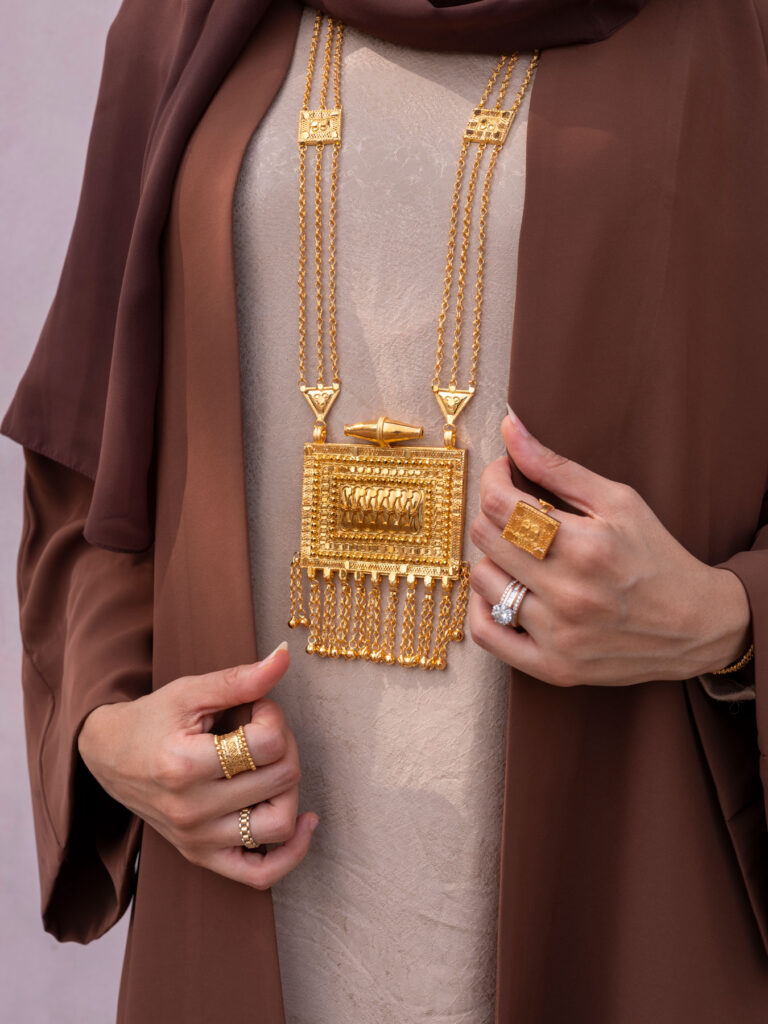
“If they see this, they don’t hesitate,” she says, twisting the heavy, shimmering bangle on screen. “Khaleejis are heavy buyers and God keep them like this,” she laughs. She plans to open a store and factory in a shopping mall within a year, where she will employ other smiths and cast limited edition pieces.
Hamed began experimenting with silver in 2010 and invested her profits in machinery. Today, the third floor of her Muscat home is a workshop, its walls lined with workbenches and machinery for polishing and pressing, its cupboards stacked with jars of pearls, tiny jewels, clasps and Hamed’s signature African malachite beads.
Working from home was a boon during the pandemic, when workshops and stores in the souk were forced to close due to public health regulations. Hamed’s business was already entirely online, with most of her sales arranged directly with buyers through WhatsApp and Instagram.
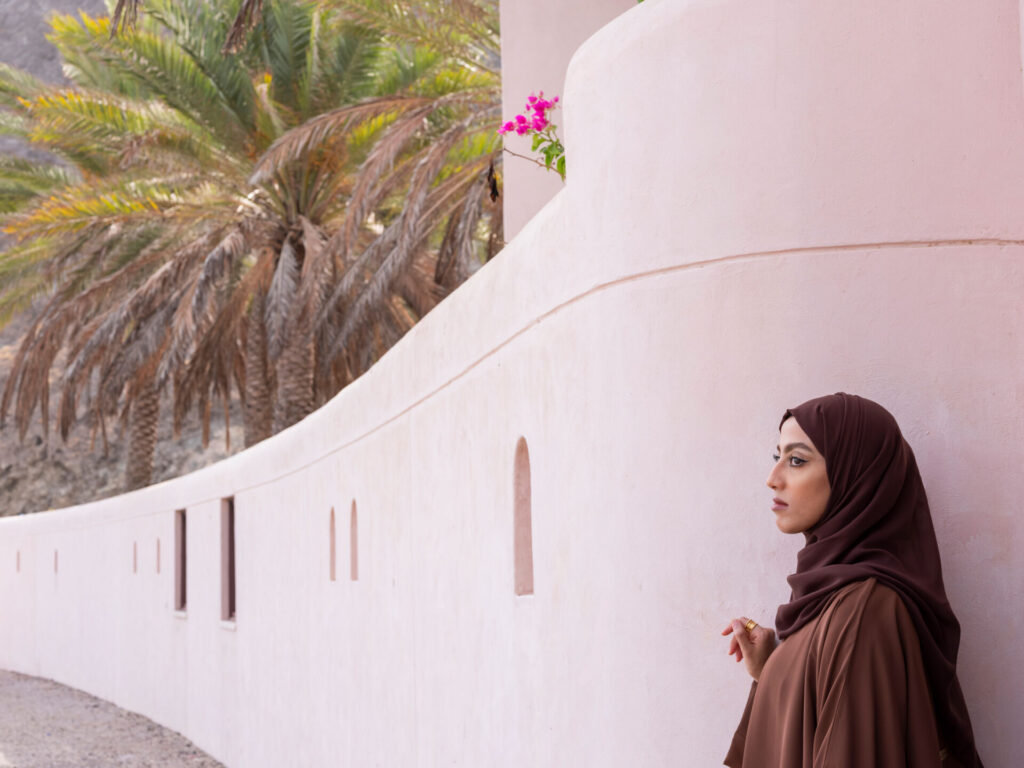
To compete with highly skilled smiths from South Asia working at factories in Muscat and Dubai, Hamed produces one-off pieces that set her brand apart. She has also begun teaching children and young adults the art of silversmithing. Nearly all of her students are women and girls.
Knowing where and how to buy materials in Dubai and Oman was once a barrier for women, as well as working long hours at the souk in conservative areas of Oman. But social media has offered an international customer base and connections to other smiths for support. “Without social media, it’s impossible that I would have reached here today,” says Hamed. “I have orders from all around the world and I’ve reached every country — Canada, Iraq, America, Australia — and this is only because of social media. Social media is a life changer.”
Meanwhile, in northern Oman, Moza Ali still faces traditional attitudes. “I’ve had men say, ‘this work is unsuitable for you, this work is only suited to men,’” says Ali, a silversmith from the mountain town of Rustaq in northern Oman. “I say, ‘you’re a man and I’m a woman. You work and I work, and I want to do this work.’” There are no difficulties now, she says, but until recently a silversmith’s ability to work depended on family support and their opportunities to acquire tools and silver.
Ali learnt smithing from a government course, and now teaches other women in Nakhal, an oasis town in the Hajar mountains. “An interest in the old life has returned, and now that women are smithing, it is stronger than ever,” she says.
Women at the forge may be a new phenomenon but they have always held an active role in the design of Omani jewelry, notes Al Ismaili. In addition to leather works, women were also intimately involved in silver jewelry design. Traditionally, necklaces were threaded instead of chained, so women took pieces apart and redesigned them to their liking. For instance, when Al Ismaili’s neighbor remarried, she unthreaded a silver necklace from her second husband and rebuilt it with pieces from a necklace gifted by her late husband. Of all of her silver, this necklace alone was so loved that she never sold it. Women would also add or remove pieces to necklaces and earrings depending on financial need.

For Al Ismaili, the largest limitation today is that Omani buyers still consider gold and silver jewelry a financial investment in the metal. Prices are based on weight, not workmanship. Additionally, government regulations to protect cultural identity forbid alterations of traditional designs. Consequently, innovation is limited and women can be held back from exploring their creativity. For this reason, she exhibits abroad and encourages her students to do the same.
In her university teaching, Al Ismaili has found that the field of jewelry is not fully accepted. During her studies in England it was considered more as art than commerce. “We have to push this concept,” she says. She adds, “I’m not against these rules, but if you keep copying tradition, you freeze it. That’s why I love contemporary jewelry. But also, I don’t want to conflict with society. … People here still do not accept the art of contemporary jewelry. But in time, maybe it will be accepted.”



